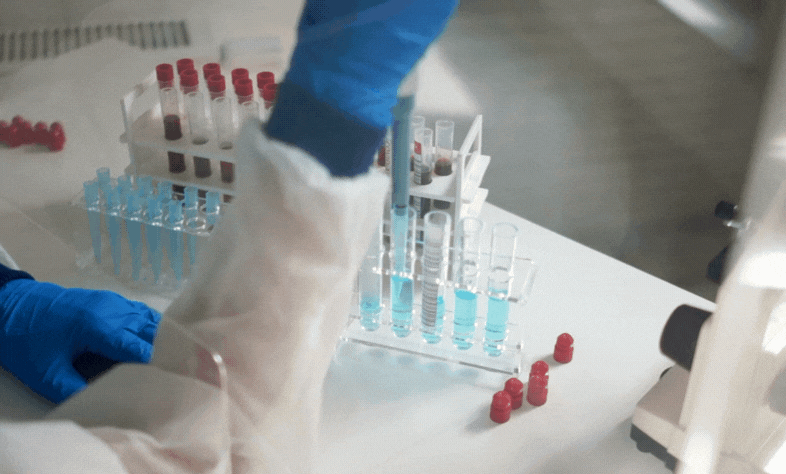
What is PCR?
Polymerase Chain Reaction (PCR) is one of the most important breakthroughs in modern molecular biology. First introduced in the 1980s, PCR made it possible to amplify specific fragments of DNA in a test tube, even if the starting material is extremely small. With this method, a single copy of DNA can be turned into millions of identical copies within just a few hours.
The principle is simple yet powerful: using temperature changes inside a PCR thermal cycler, DNA is repeatedly denatured (separated), targeted by short primers, and copied by a DNA polymerase enzyme. This cycle repeats 25–40 times, resulting in exponential DNA amplification.

What is qPCR / Real-Time PCR?
Quantitative PCR (qPCR), also called Real-Time PCR, is an advanced version of the classical PCR technique. While conventional PCR only tells you if DNA is present at the end of the reaction, qPCR measures the DNA in real time as it is amplified cycle by cycle.

Why is qPCR important?
Provides accurate and real-time quantification of DNA or RNA.
Detects very low levels of pathogens (viruses, bacteria, fungi).
Helps researchers monitor gene expression under different conditions.
Essential for clinical diagnostics, such as cancer biomarkers or infectious diseases (influenza).
At the heart of PCR are three essential steps, repeated 25–40 times depending on the experiment:
The PCR Cycle : Step by Step
Step | Temperature Range | What Happens | Key Outcome |
1. Denaturation | ~94–98 °C | The double-stranded DNA separates into single strands. | Provides access to the target DNA sequence. |
2. Annealing | ~50–65 °C | Short primers attach (anneal) to the complementary sequences on the single-stranded DNA. | Ensures specificity of amplification. |
3. Extension / Elongation | ~72 °C | DNA polymerase (commonly Taq polymerase) adds nucleotides to build new DNA strands. | Creates new double-stranded DNA molecules. |

Main PCR Variants :
PCR Technique | Definition | Key Applications |
Conventional PCR | The original method of DNA amplification, where results are detected at the end using gel electrophoresis. | Cloning, genotyping, mutation analysis. |
qPCR (Quantitative PCR) | Also called Real-Time PCR. Measures DNA quantity cycle by cycle using fluorescent dyes or probes. | Gene expression analysis, pathogen detection, clinical diagnostics. |
RT-PCR (Reverse Transcription PCR) | Converts RNA into complementary DNA (cDNA) before amplification. | Studying RNA viruses , analyzing gene expression. |
Digital PCR (dPCR) | Divides a sample into thousands of partitions for absolute DNA quantification. | Rare mutation detection, precision diagnostics, liquid biopsy testing. |
Multiplex PCR | Uses multiple primer sets in one reaction to amplify several DNA targets simultaneously. | Detecting multiple pathogens in one test, forensic DNA profiling. |

PCR Thermal Cyclers: The Heart of Amplification

03

Distribution
Guarantees consistent amplification across all wells.

PCR and qPCR have diverse applications across multiple fields:

Forensics and Paternity Testing:
DNA profiling for legal cases. Read more
PCR Reagents and Consumables

DNA Polymerases

Master Mixes
Ready-to-use formulations containing buffer, nucleotides, and enzymes for convenience and reduced errors.

Primers and Probes
Short DNA sequences designed for specificity, ensuring only the target DNA is amplified.
01

Designed to withstand rapid temperature cycling without leakage or evaporation.
02

Allow high-throughput experiments for research and diagnostics.
03

Why Choose the Right PCR Thermal Cycler?
Selecting the best PCR thermal cycler is crucial for reliable results. The right instrument saves time, improves reproducibility, and adapts to different research or diagnostic needs.
|
| |||
Precision | Accurate temperature control ensures consistent amplification. | |||
Scalability | From single tubes to 96-well and 384-well formats for higher throughput. | |||
User-Friendly Software | Simplifies programming and minimizes human error. | |||
Reliability and Service | Ensures consistent performance and long-term support. |

Featured PCR and qPCR Instruments

Compact Cyclers
Ideal for small labs, teaching environments, and entry-level applications.

High-Throughput qPCR Systems

Specialized Models
Tailored solutions for clinical, food safety, and molecular biology testing.
FAQ frequently asked questions
PCR and qPCR Questions
What is the difference between PCR and qPCR?
PCR (Polymerase Chain Reaction) amplifies DNA and shows results at the end of the experiment using gel electrophoresis.
qPCR (Quantitative PCR), also called Real-Time PCR, measures DNA amplification as it happens, giving quantitative results in real time.
How long does a PCR reaction take?
A standard PCR experiment typically takes 1–3 hours, depending on the number of cycles and the DNA fragment size. High-throughput qPCR systems may run multiple samples faster with automated software.
What machine is used for PCR?
PCR requires a PCR thermal cycler, also known as a PCR machine. It precisely controls temperature cycles for denaturation, annealing, and extension, which are essential steps for DNA amplification.
What reagents are needed for PCR?
Essential PCR reagents include:
DNA polymerase :enzyme that synthesizes DNA.
Primers :short sequences that target specific DNA regions.
dNTPs:nucleotides used to build new DNA strands.
Buffer solutions:maintain the optimal environment for polymerase activity.
Consumables :tubes, plates, and sealing films compatible with thermal cyclers.
How can I avoid contamination in PCR experiments?
- Use sterile pipette tips and consumables.
- Prepare reagents in a clean workspace separate from DNA samples.
- Use dedicated equipment for pre- and post-PCR procedures.
- Follow strict lab best practices to ensure reproducible results.
Why Thermal Cycles Matter in PCR?
Thermal cycles are the core of the PCR process. Without precise heating and cooling, DNA cannot be efficiently amplified. Each cycle consists of three main steps:
Denaturation (High Temperature) :DNA strands separate, allowing primers access to the target sequence.
Annealing (Lower Temperature) :Primers bind specifically to their complementary DNA sequences.
Extension (Optimal Temperature) :DNA polymerase synthesizes new DNA strands, doubling the DNA amount.
Repeating these steps 25–40 times results in exponential DNA amplification.







